![]()
![]()
![]()
Use LEFT and RIGHT arrow keys to navigate between flashcards;
Use UP and DOWN arrow keys to flip the card;
H to show hint;
A reads text to speech;
30 Cards in this Set
- Front
- Back
|
Satiety |
is a state or feeling of fullness after eating and when there is no further desire for food.
Foods differ in their ability to give us a sense of satiety. This is a result of the nutrients they contain and the way in which they are processed and prepared. |
|
|
Appetite |
is the desire for food, even when the body is not hungry. May be explained as a conditioned response to food; that is, it can be triggered by the sight of appealing food, the aroma of food, or even the mention of food in converstation. |
|
|
Hunger |
is the drive to satisfy the need for food. Your body lets you know when you are running low on fuel and this is the sensation of hunger. Hunger instinctively protects the body from exhausting energy reserves. |
|
|
Sensory properties of food |
The characteristics of food as they are perceived by the senses of sight, smell, taste, touch and hearing, enables us to describe and explain to others why we enjoy or dislike particular foods. |
|
|
Sensory appreciation of food |
That is, the information we get from our senses about food and how we interpret that information. |
|
|
Digestion |
is the process by which food is broken down into substances that can be absorbedand utilized by the body. |
|
|
Mechanical digestion |
is the use of physical force to break down food, such as chewing or the squashing movementof the intestines. |
|
|
Chemical digestion
|
isthe break-down of food using chemicals such as enzymes and acids.
|
|
|
Saturated fats
|
containthe maximum amount of hydrogen.
|
|
|
Unsaturated fats
|
canbe monounsaturated or polyunsaturated fats.
|
|
|
Trans fats
|
arecreated artificially by a process called hydrogenation.
|
|
|
Macronutrients |
are the essential nutrients required by the body in large amounts. Supply the body with, promote growth and the repair of tissues and regulate body processes. -fats -carbs -protein |
|
|
Eyes and Nose |
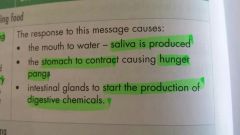
Sight and aroma of food creates a sensory appreciation of the food- sends signals to the brain: |
|
|
Enzymatic hydrolysis |
is a chemical digestive process that breaks down food by breaking the bonds thathold together the molecular ‘building blocks’ within the food. Reactions occur when an enzyme incorporates a water molecule accross the bond, allowing it to break. |
|
|
Glycaemic Index (GI) |
is a measure of how fast and how much a food raises bloodglucose levels. |
|
|
Flavour
|
isa combination of the taste and aroma of the food.
|
|
|
The senses |
Appearance Aroma Flavour Texture |
|
|
Mouth, teeth and tongue |
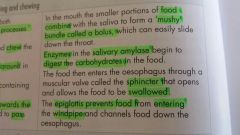
Mechanical and chemical digestion, -Teeth bite and chew -tongue move food around mouth and pushes food towards sphincter -salivary glands release saliva |
|
|
Oesophagus |
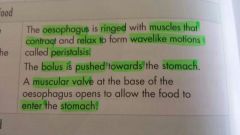
Bolus (small soft ball of food) enters assisted by a 'rush' of saliva |
|
|
Stomach |
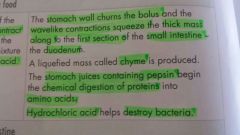
Bolus enters stomach, glands release mixture of gastric juices |
|
|
3 parts of the small intestine |
Duodenum Jejunum Ileum |
|
|
Duodenum |
-Pancreatic fluid released, contains digestive enzymes and insulin Insulin helps to regulate the amount of sugar in the blood -Enzymatic hydrolysis occurs Pancreatic Lipase digests fats producing fatty acids and glycerol. Pancreatic enzyme protease splits proteins into seperate amino acids.
-Bile is released from the gall bladder
-Bile is released from the Liver Emulsifies fat
|
|
|
Jejunum and Ilium |
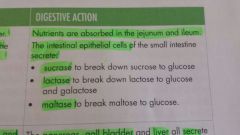
-Food is squeezed into the lower parts of the small intestine. -Nutrients are absorbed for energy or used as building blocks for new tissue. -specialised cells 'villi" in the intestinal walls collect sugars, amino acids, fatty acids, and glycerol. |
|
|
Large intestine/colon |
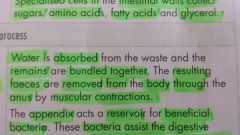
Once nutrients ard absorbed, indigestible remainder moves onto the large intestine -bacteria breaks down some of the fiber |
|
|
Appendix |
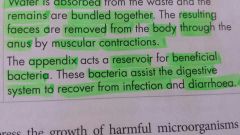
Found in the junction of the small and large intestine |
|
|
Microbiology of the intestinal tract |
Microflora perform many important and useful metabolic and fermentation activities in the intestine. -improve digestion and absorbtion of short chain fatty acids -assist with synthesis of vitamins B and K -aid in digestion of lactose -improve bodies resistance to infections, repress growth of harmful microorganisms or pathogenic bacteria -assist in the digestion of fibre, ferment idigestible carbs and collect their energy. |
|
|
Absorbtion of macronutrients |
Villi are small finger like projections that line the surface of the small intestine. Increases surface area for absorbtion of nutrients. -Glucose is absorbed through the blood capilleries -Fats absorbed into lacteals (connected to the lymphatic system) |
|
|
Carbohydrates |
Body's main supplier of energy -sugars broken down into glucose -glucose absorbed into blood capillaries -transported in blood -pancreas, insulin, helps glucose move to blood stream -excess glucose, converts to glycogen, stired in liver and muscle tissues. |
|
|
Proteins |
-broken down into amino acids -absorbed in blood capillaries, dissolve in blood and carried to the liver for storage -Amino acids are building blocks for protein synthesis for the creation of new tissue, cells and hair -Also for, enzymes and hormones (body chemical) |
|
|
Fats |
-broken down into fatty acids and glycerol -absorbed into the lacteal (found in the villi of the small intestine) -recombine to form fats, which mix with lymphatic fluid -move around the body, join blood circulation as insoluble fat -converted to soluble fat in the liver |

